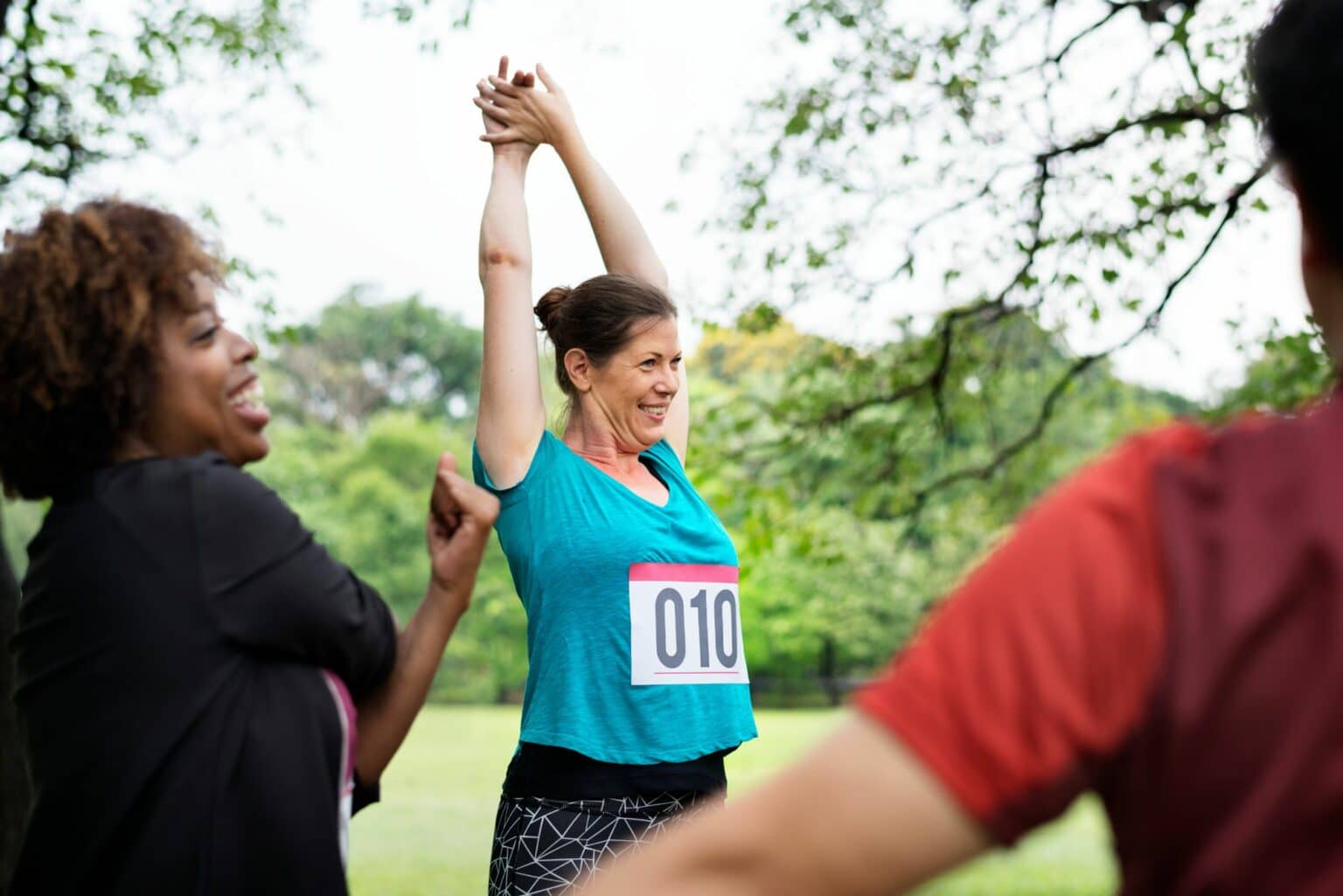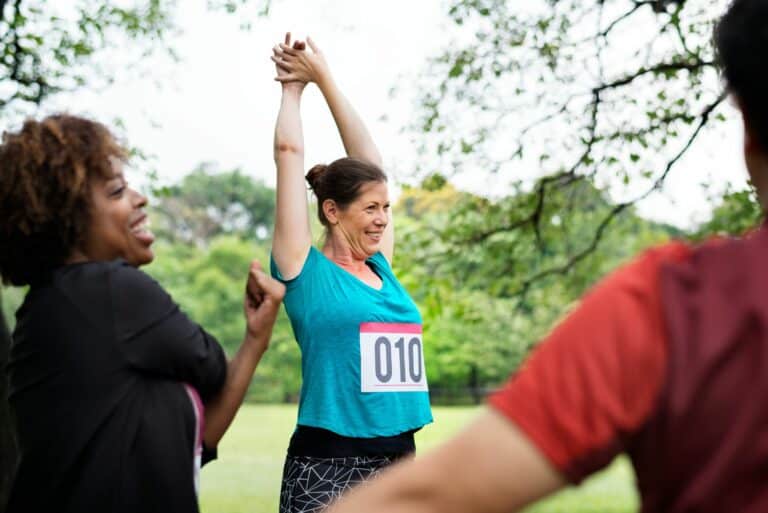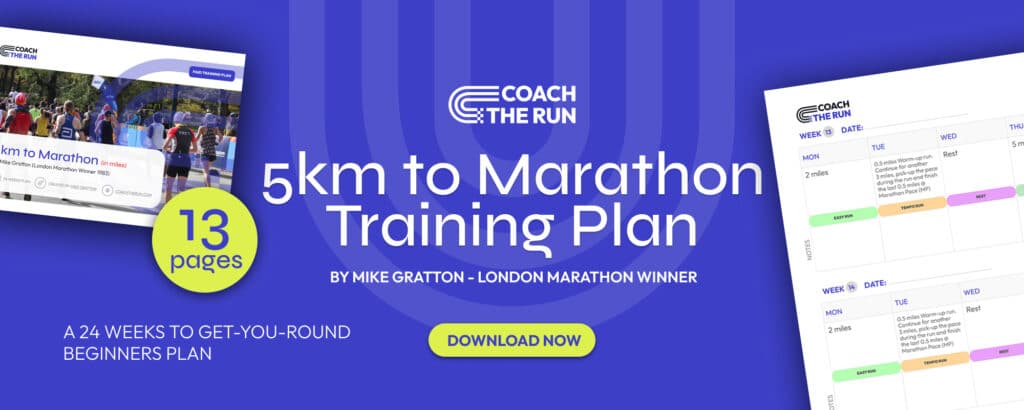


Running is one of the simplest and most efficient exercises beginner runners can do. It requires no special equipment, can be done anywhere, and has numerous health benefits. However, for someone who has never run before, it can seem daunting and overwhelming.
Just starting out?
This guide to how to learn to run for absolute beginners has some top tips to help you get going!
Before diving into how to learn to run, it’s important to understand the benefits of this exercise. Running can improve cardiovascular health, strengthen your muscles and bones, boost your immune system, and help with weight management. It also has mental health benefits, such as reducing stress and improving mood. It enhances overall well-being and quality of life and can help you to set and achieve personal goals. Running also allows you to join a community of like-minded individuals
One of the keys to success in learning how to run is setting achievable goals and finding motivation. Your goals should be specific, measurable, and time-bound. For example, instead of saying, “I want to start running”, set a goal like “I will run for 20 minutes three times a week for the next month”. This gives you something concrete to work towards.
Finding motivation can be tough, especially when starting something new. Some ideas to help with motivation include:
By setting goals and finding motivation, you can stay focused and determined on your journey to learning how to run.
Running is an excellent way for beginners to improve their physical and mental health. Regular running can help you lose weight, increase energy levels, and reduce stress. It can also improve your sleep quality, boost your mood, and enhance your overall well-being. Additionally, running can help you develop a sense of discipline and self-confidence, which can translate to other areas of your life. As a beginner, it’s essential to understand the benefits of running and how it can positively impact your life.

Before jumping into a running routine, it’s essential to prepare your body for the physical demands of this exercise. This includes:
It’s crucial to listen to your body and start slowly, gradually increasing intensity and duration over time. Don’t push yourself too hard, as it could lead to burnout or even injury.
Consistency is key when starting a new running routine. It’s essential to have a plan and stick to it. Here at Coach the Run we offer a free Beginners Couch to 5k Training Plan to help you get started. This plan is designed for absolute beginners and gradually builds up your endurance over eight weeks.
Some tips for building a running routine include:
Whatever routine works best for you, the key is consistency. Stick with it, and you will see progress and improvement over time.
Starting an exercise routine with brisk walking is an excellent foundation for preparing your body to run. It builds endurance and strengthens muscles before you tackle the more intense demands of running. Begin with short walks and gradually extend both distance and duration. Include dynamic warm-ups and cool-downs, and pay attention to proper walking form and technique. Gradually incorporate running segments into your walks. Always listen to your body and take rest when necessary.
Incorporating strength training into your running routine can help improve your performance and reduce your risk of injury. Focus on exercises that target your core, glutes, and legs, such as squats, lunges, and deadlifts. These exercises can help improve your running form, increase your endurance, and enhance your overall running efficiency. Aim to do strength training exercises 2-3 times per week, and make sure to include rest days in between to allow your muscles to recover.
Flexibility and mobility exercises are essential for runners, as they can help improve your range of motion and reduce your risk of injury. Focus on exercises that target your hips, knees, and ankles, such as leg swings, hip circles, and calf raises. You can also incorporate stretching exercises into your routine, such as hamstring and quadriceps stretches. Aim to do flexibility and mobility exercises 2-3 times per week, and make sure to hold each stretch for 15-30 seconds.
The run-walk method is a favoured approach for easing into running. By alternating between walking and running intervals, it becomes more accessible for beginners. As your endurance builds, you can gradually extend the time spent running. Begin with brief running segments interspersed with walk breaks, and slowly increase the distance and duration of your runs. Pay attention to proper form and technique, and use walk breaks to prevent burnout and injury.
Running drills can help improve your running form and endurance. Focus on drills that target your posture, foot strike, and breathing, such as high knees, butt kicks, and cadence drills. You can also incorporate hill sprints and interval training into your routine to improve your endurance and speed. Aim to do running drills 1-2 times per week, and make sure to start slowly and gradually increase your intensity and duration.
Once you have built a solid foundation with walking and using the walk-run method, you can gradually increase your running distance and duration. Remember to listen to your body, take rest days, and adjust your routine as needed. Keep track of your progress, celebrate milestones, and don’t be too hard on yourself if you have setbacks.
Maintaining proper running form is vital for preventing injuries and maximising efficiency. It not only enhances the overall running experience but also boosts confidence and motivation, helping to establish a consistent running habit. A well-rounded training program is essential for maintaining proper running form, as it incorporates elements such as warm-ups, strength training, mobility, and cross-training workouts.
Some key elements of good running form include:
Don’t be afraid to seek guidance from experienced runners or professional coaches if you are unsure about proper running technique.

Investing in proper gear is essential for both comfort and safety while running. The most crucial piece of equipment is a good pair of running shoes that fit well and provide adequate support. Other gear considerations include moisture-wicking clothing to stay comfortable and dry. Opt for reflective or high-visibility attire if you’re running in low-light conditions, and use a headlamp or reflective accessories for nighttime runs. Don’t forget a water bottle or hydration pack, particularly for longer distances.
Be sure to do some research and try out different options before settling on the right gear for you.
Choosing the right pair of running shoes is essential for injury prevention and optimum performance. Consider factors such as your foot shape, running style, and the surface you’ll be running on when selecting a shoe. It’s also crucial to replace your shoes regularly, as worn-out shoes can cause injuries. Visit a speciality running store to get fitted properly or seek guidance from experienced runners or coaches.
When searching for the ideal first pair of running shoes, consider these key features: adequate support and cushioning, breathable and moisture-wicking materials, reflective or bright colours for visibility, a comfortable and secure fit, and suitability for your foot type and running style.
We recommend the Brooks Ghost 15, priced at £94.50. These shoes offer a balance of comfort, support, and durability for beginners.
If you overpronate and require a shoe with more support, we recommend the Saucony Tempus, priced at £82.94.
You’ve sorted the gear and shoes; you now need to find a suitable running spot. Look for well-lit areas with minimal traffic, pedestrian paths, and sidewalks if possible. Consider the terrain and elevation changes to add variety to your runs.
Using a running app, smartwatch, or fitness tracker can help you track your progress and stay motivated. It allows you to set goals, monitor your distance and pace, and track improvements over time. Some apps also offer personalised training plans and allow you to connect with other runners for accountability and support.
As a beginner, you may face challenges such as a lack of motivation, feeling self-conscious, or struggling to find time and energy to run regularly. Remember that it’s normal to have ups and downs with any new habit. Celebrate your progress, find an accountability partner or running group, and remember why you started in the first place.
It’s common to experience discomfort or minor injuries when starting a new activity. Listen to your body and take rest days when needed. Incorporate stretching and foam rolling into your routine. Gradually increase your running distance and intensity. If you encounter an injury, seek medical advice and adjust your routine as needed.
To stay motivated, set achievable goals and reward yourself for progress. Also, mix up your routine with different routes and running surfaces, try new music or podcasts, and use running as a way to explore new places. Take rest days when needed, and listen to your body if you feel burnt out.
If finding time to run is challenging, try scheduling it into your daily routine or breaking it into shorter sessions throughout the day. Use technology to track your progress and hold yourself accountable. Remember that every little bit counts towards building endurance and achieving your goals.
While running is a great form of exercise, it’s essential to incorporate other forms of physical activity for overall fitness and injury prevention. Consider adding strength training, yoga or Pilates, and cross-training activities such as cycling or swimming into your routine.
Rest days are just as important as running days to prevent burnout and injury. Use these days to incorporate other forms of physical activity, such as cross-training or low-impact exercises like swimming or cycling. These activities can also help improve your overall fitness and support your running goals.
Along with a balanced fitness routine, it’s crucial to maintain a healthy diet and lifestyle. Fuel your body with nutritious foods and stay hydrated before, during, and after runs. Get enough sleep and manage stress levels to support your overall well-being and running performance.
Ready to hit the pavement and start your running journey? Our Coach the Run Beginners 5k Training Plan is designed to help you gradually build endurance over 8 weeks and reach your first 5k race. It includes a mix of running, walking, and rest days to prevent injury and burnout. Remember to listen to your body and adjust as needed.
Congratulations on taking the first step towards becoming a runner! Remember to choose appropriate gear and shoes, find a safe running environment, use technology to track your progress, and overcome challenges along the way. With dedication, consistency, and patience, you’ll soon be conquering your first 5k race.
Download our Coach the Run Beginners 5k Training Plan today, and let us guide you through your journey to becoming a confident runner!
Join our mailing list to stay up to date with the latest UK running events, training tips, and exclusive offers on running products. Rest assured, we value your privacy and would never dream of selling your address. Sign up now…
___
Disclaimer: It is always recommended to consult with a medical professional before beginning any new fitness routine or making significant changes to your diet or lifestyle.
___
Share this article
Welcome to the world of heart rate variability (HRV). In this guide, we will be...
Just entered a half marathon? You’re taking on a fantastic distance that presents a real...
I am going to be away on a family holiday, and I won’t have much...
Running cadence is an essential aspect of running that can greatly impact your performance and...
As much as we love taking our furry companions on runs with us, it’s important...
Elevation gain refers to the total cumulative vertical distance ascended during a sport activity, such...
We’re here to make sure you’re up-to-date with the latest running tips, events and product discounts – we’ve always got your back! Rest assured, we value your privacy and would never dream of selling your address.
BONUS: Sign up today and receive a FREE code for our Sub-4-Hour Marathon Plan